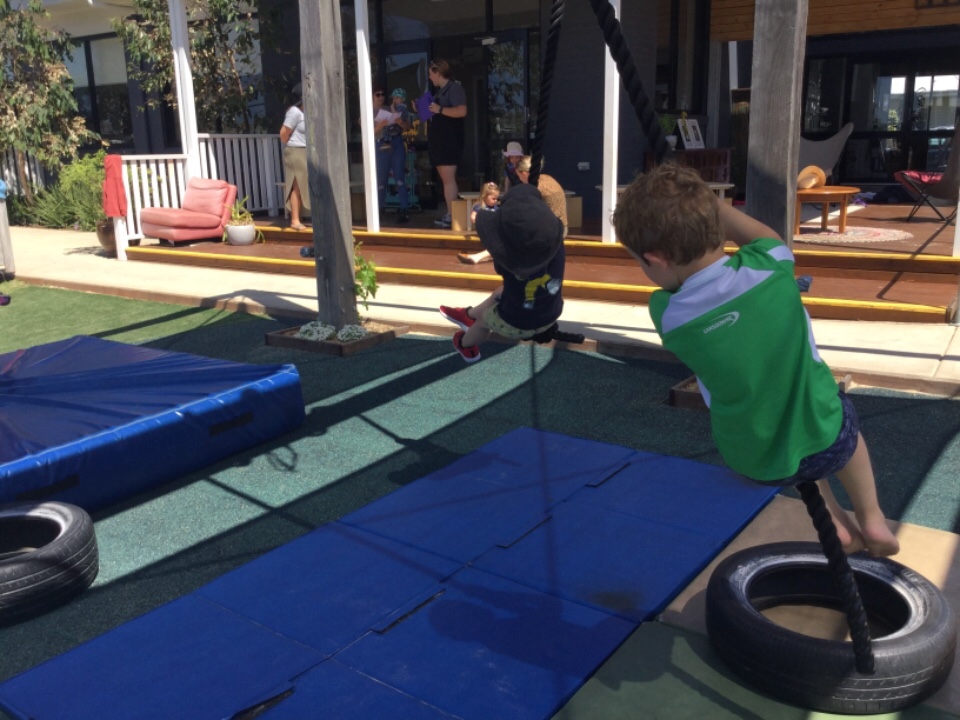Exploring the value of outdoor learning

Tomorrow, 7 November, is Outdoor Classroom Day. What began as an initiative by a handful of London schools in 2012 has now evolved into a “truly global movement” which, in Australia, is lead by NGO Nature Play with the support of Semble and Unilever’s Omo team.
In the interests of exploring examples of best practice in this space, The Sector reached out to Ella de la Motte, Nominated Supervisor of The Rumpus Room Chatham St, one of a group of three centres in the New South Wales Hunter & Lake Macquarie regions. We spoke to Ms de la Motte about inspiring outdoor environments, the role of intentionally planned spaces outdoors, and innovative practice.
Painting a picture
Part of the stated mission of The Rumpus Room is to “create and continuously improve centres that delight children, impress parents, and inspire staff”. We asked Ms de la Motte what role the outdoor environment has to play in achieving that goal.
Being flexible, and in tune with the children, is the secret to this success, she said, adding “We aim to give the children as much choice as possible. Our large yard provides multiple zones and areas children can have their own space to play and explore. Given the choice, the majority of the children, the majority of the time, choose to be outside.”
Paying deep attention to individual needs, and being willing to be flexible means there is an environment of “limitless possibility; not only for our children, but for our staff as well. It is a safe space to experiment, explore, test boundaries, take risks, not only in the physical sense,” she added.
When asked to describe the space, Ms de la Motte said the outdoor area at the Chatham St centre is the space where people gather to meet daily and share ideas. “The feel we aim for is a Sunday walk in the park or around the markets. The group of educators get to know all of the children and their families mostly through this shared space. The children spend time with their siblings, cousins, friends from playgroup and friends in varying age groups.”

The space is also healing, allowing children to settle more easily into the centre, or manage transitions, because of its familiarity and friendly faces.
“We have critically reflected on the transition process from one room to the next and realise that the one continuous staple and secure place for children is the outdoors area. When the new year starts, families are often surprised at how well the next room up already knows their child – that’s because of the shared time in the outdoor space,” Ms de la Motte said.
An atmosphere for learning
Subscribing to the belief that the environment is the third teacher, Ms de la Motte said the team aims to create spaces which are “aesthetically pleasing, while still being homely, engaging, interesting, and accessible”.
“We believe in creating beautiful spaces for children to spend their days, including sleeping spaces outdoors if that is what they feel like. There are unique furnishings, furniture and resources. Lots of natural elements to counter-balance the non-natural elements we have within the space,” she added.
Many of the items found within the environment come from weekend markets, marketplace, recycling centres, quirky second hand stores and buy-swap-sell pages on social media.

“We feel this gives us a unique and character filled space. If we find something that needs to be built or fixed, great, we have a team of dedicated preschoolers who love working with real tools and pictorial instruction guides,” Ms de la Motte added.
Creating a sense of freedom within the outdoor and indoor environments is also a priority, with spaces to be alone, or to gather in a small or large group. “I will often say to visitors, there are 64 children here, but we hope they feel they are one of one, not one of 64,” Ms de la Motte said.
Mutual respect, trust and freedom
A sense of shared responsibility for the resources and the space is created by having a culture of sharing within the centre. Resources do not belong to any one space, class, or group of people, but are instead freely shared, with indoor/outdoor play encouraged.
The presence of “many loose, moveable, transportable parts and plenty of baskets to help with transporting” ensures that children are limited only by their imagination, with “a beautiful flow and fluidity” to the movement of children across the centre.
“We discuss often, the outdoors is not a place for torn books, home corner furniture that is missing parts or other broken items. It is a space where we learn to respect objects, the environment and the people within. The outdoors pieces are to be as respected and cared for as in the indoors,” Ms de la Motte said.
The culture of sharing extends beyond resources and furniture. Being in a shared space for 90 per cent of the day or more means that educators and children have the opportunity to learn from one another.
One early childhood teacher working with The Rumpus Room described the outdoor environment as being a direct reflection on the practices of ‘mutual respect, trust & freedom’, which Ms de la Motte says, “flows down from the owners of the centre, through the Nominated Supervisor, to the team of educators, to the children and then to the families.”
This, she says, means that educators stay inspired through utilising their strengths and developed skills to make decisions without the need to check in or seek permission at every level.
“As the Director,” Ms de la Motte added “I trust they will make well thought through decisions, consider risk vs benefit and work together to create amazing spaces for children. They trust that if they need support (time, resources or budget) that the owners and I will be supportive of them.”
Innovative practice
When asked for examples of innovative practice, or the way in which the design of the outdoor space has transpired, to provide inspiration to other services, Ms de la Motte offered the following:
- “We look for experiences for the children, the families and us as a team that give us those ‘wow’ moments – one of these so far have been pendulum painting, both with a can attached to string hanging, and in human form with children being able to have their body nestled in a hammock, pouring paint as they swung back and forth. The collaborative artwork that came as a result hangs proudly in one of the centre’s art galleries through the hallways.
- After careful consideration and planning, and with a need for more shaded space in the expansive outdoor area, we created a recycled timber sleeper structure that we planned to be as multi-functional as possible.
- We have seedless grape vines growing up (and over hopefully soon), we have flower garden beds underneath each post. There are a range of hooks on the structure that support dual battle ropes, hammock nests for resting, cargo nets for climbing on and we even have a pulley system set up where children work together to raise and lower items, each other and even one of our teachers had a turn!

- We identified that parents were feeling guilty for not giving their child breakfast prior to arriving, so we created an outdoor breakfast space where children can bring their breakfast from home, sit with their friends or an educator to eat, share a warm pot of fruit tea and begin their day. It has changed from a guilt-driven breakfast to an open offer that supports busy families, purely by us providing the space, it says we want you to join us for breakfast!
- We don’t rely on ‘supervision plans’ as we fluidly move with the children who are mostly engaged and busy. We have very low incidents of behavioural issues, particularly in stark contrast to years gone by, where little faces looked longingly out the window or door to the outdoor space that they couldn’t access.”
With the centre boasting 100 per cent occupancy for most of 2019, and currently at 100 per cent occupancy for 2020, Ms de la Motte said the “amazing reputation and standing within the community” was down to many local businesses and families having heard positive stories of children’s time here with us, alongside the innovative practice and outdoor learning environment.
Popular

Quality
Practice
Provider
Research
Workforce
Honouring the quiet magic of early childhood
2025-07-11 09:15:00
by Fiona Alston

Practice
Provider
Quality
Research
Workforce
New activity booklet supports everyday conversations to keep children safe
2025-07-10 09:00:16
by Fiona Alston

Quality
Practice
Provider
Workforce
Reclaiming Joy: Why connection, curiosity and care still matter in early childhood education
2025-07-09 10:00:07
by Fiona Alston












